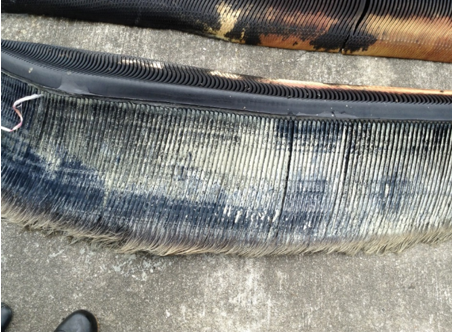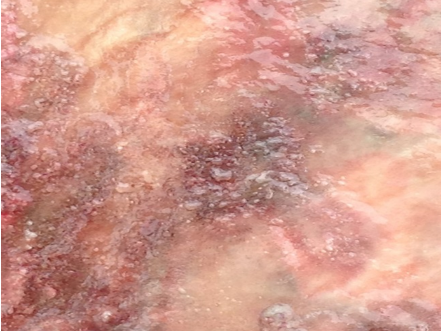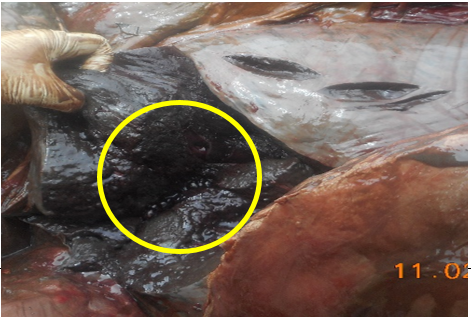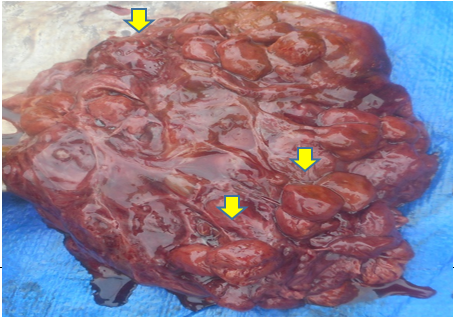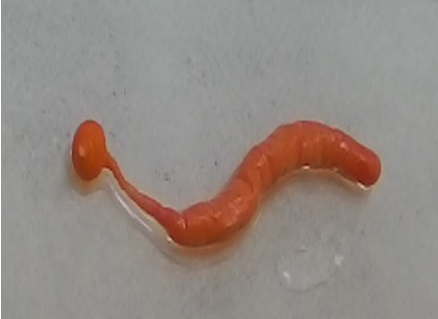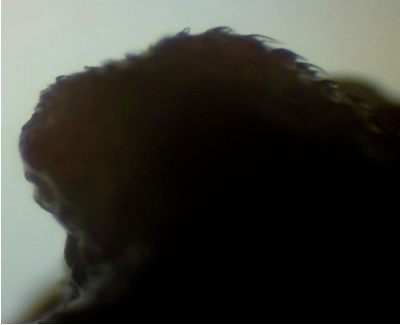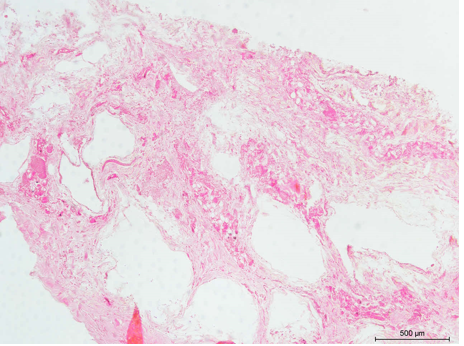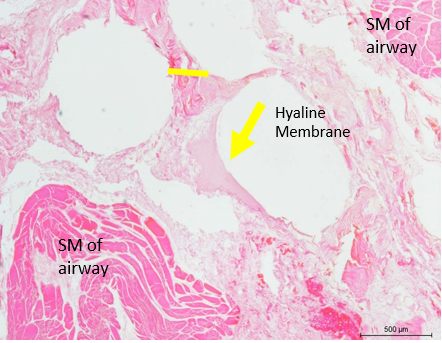Research Article
Volume 2 Issue 1 - 2020
Decompression Sickness (DCS) in a Sei Whale (Balaenoptera Borealis) Stranded In Batu Pahat, Johore, Peninsular Malaysia
1Department of Veterinary Services State of Johor, Aras 4, Bangunan Dato’ Mohamad Ibrahim Munsyi 79630 Kota Iskandar, Nusajaya, Johor
2Regional Veterinary Laboratory Johor Bahru, 2Department of Veterinary Services, Lot PTB 11098, Jalan Taruka, Off Jalan Datin Halimah, 80350 Johor Bahru, Malaysia.
3Faculty of Veterinary Medicine, University Putra Malaysia, Serdang, Selangor, Malaysia
4Department of Veterinary Services, Ministry of Agriculture and , Wisma Tani, Blok Podium Lot 4G1 & 4G2, No. 28 Persiaran Perdana, Presint 4, 62630 Putrajaya, Malaysia.
5Department of Fishery Johor, Tingkat 6, Blok A, Wisma Persekutuan, Jalan Air Molek, Johor, 80100 Johor Bahru
6Fishery Research Institute (FRI) Rantau Abang, Pusat Penyu dan Ekosistem Marin (TUMEC), Jabatan Perikanan Malaysia, 23050 Dungun Terengganu
2Regional Veterinary Laboratory Johor Bahru, 2Department of Veterinary Services, Lot PTB 11098, Jalan Taruka, Off Jalan Datin Halimah, 80350 Johor Bahru, Malaysia.
3Faculty of Veterinary Medicine, University Putra Malaysia, Serdang, Selangor, Malaysia
4Department of Veterinary Services, Ministry of Agriculture and , Wisma Tani, Blok Podium Lot 4G1 & 4G2, No. 28 Persiaran Perdana, Presint 4, 62630 Putrajaya, Malaysia.
5Department of Fishery Johor, Tingkat 6, Blok A, Wisma Persekutuan, Jalan Air Molek, Johor, 80100 Johor Bahru
6Fishery Research Institute (FRI) Rantau Abang, Pusat Penyu dan Ekosistem Marin (TUMEC), Jabatan Perikanan Malaysia, 23050 Dungun Terengganu
*Corresponding Author: Norina L, Department of Veterinary Services State of Johor, Aras 4, Bangunan Dato’ Mohamad Ibrahim Munsyi 79630 Kota Iskandar, Nusajaya, Johor.
Received: April 06, 2020; Published: April 15, 2020
Abstract
Decompression sickness, which is caused by bubble formation from dissolved inert gas. It occurs when gas bubbles form in certain body tissues during transition from a high pressure environment to one of lower pressure, resulting in a range of conditions from itching to joint pain, convulsions, and death. A stranded Sei Whale, Balaenoptera Borealis on the shore of southern Peninsular Malaysia was examined for cause of death. In this case, the Si Corner have the lung problem earlier. This can be seen in histopathology with the formation of fibrosis, emphysema and edema in the lung. Si Corner also suffer from chronic starvation with the present of hepatic atrophy. It believed that he also suffering from “Barotrauma or Decompression Sickness” where affecting ear or lung problem which lead to unbalance movement due to different changes in air pressure.
Keywords: Sei Whale; Balaenoptera Borealis; Barotrauma; Decompression sickness; Peninsular Malaysia.
Introduction
The sei whale Balaenoptera borealis is the third largest member of the Balaenopteridae family, after the blue whale B. musculus and the fin whale B. physalus, and is one of the least known mysticete whales. The species is cosmopolitan, inhabiting the world’s temperate to subpolar oceans, with generally antitropical distribution centred in temperate zones. Sei whales are thought to undertake seasonal migrations from low-latitude wintering areas to high-latitude summer feeding grounds. The locations of winter calving grounds are unknown (Perry et al., 1999), and summer distribution on the feeding grounds exhibits great year-to-year variability (Jonsgård and Darling 1977). Throughout their range, sei whales occur predominately in deep waters. Sei whales feed primarily on calanoid copepods and euphausiids, although small schooling fishes and squid form an important part of their diet in some areas (Horwood J, 1987).
Decompression sickness (DCS) is the syndromes associated with the liberation of gas originally held in solution into a free gas phase within the tissues of the body consequent to a reduction in barometric pressure. This gas phase can most easily be detected in the form of venous bubbles. They are called venous gas emboli (VGE) (Nishi RY., 1993). Arterial gas embolism (AGE) occurs secondary to pulmonary barotrauma when gas is forced into the pulmonary vasculature. There are a few earliest, syndrome of DCS such as Bends, Chokes and Skinny bends.
Bends is characterized by deep, boring pain in a large joint. The hips, elbows, and knees are most commonly affected. Symptoms generally occur within 6 h of exposure but on occasion will first develop as long as 12 to 24 h after exposure. The term, bends is most often used to describe the syndrome of musculoskeletal pain (i.e., spinal cord bends, skin bends, etc.). Surprisingly little is known about its pathophysiology.
Bends is characterized by deep, boring pain in a large joint. The hips, elbows, and knees are most commonly affected. Symptoms generally occur within 6 h of exposure but on occasion will first develop as long as 12 to 24 h after exposure. The term, bends is most often used to describe the syndrome of musculoskeletal pain (i.e., spinal cord bends, skin bends, etc.). Surprisingly little is known about its pathophysiology.
Chokes: When symptoms of cough, substernal chest pain (usually described as burning), and shortness of breath with or without hemodynamic collapse occur. This form of (cardiopulmonary) DCS is thought to be due to an extremely high load of VGE in the pulmonary artery. Increased pulmonary artery and right ventricular pressures, possibly associated with the generation of increased interstitial fluid, play a major role in the development of this form of DCS. It is most commonly seen in the period immediately following decompression.
Skin (or skinny) bends: There are a variety of cutaneous signs and symptoms associated with decompression, and not all are specifically classified as DCS. When one is decompressed in a chamber, after a relatively deep and brief exposure in a dry environment, diffuse cutaneous itching is a frequent if not uniform experience. This symptom is thought to be due to transcutaneous passage of gas and therefore is almost never seen in a wet environment. It is generally considered to be a benign consequence of exposure and not usually treated with recompression.
This paper reported the Decompression Sickness (DCS) in a Sei Whale (Balaenoptera Borealis) stranded in Batu Pahat, Johore, Peninsular Malaysia.
Material and Method
On February 2016, a Sei whale (Balaenoptera borealis) named ‘Si Corner’ by villages was found stranded 50 meter from Rambah Beach, Pontian, Johore, was found stranded dead on the beach near Batu Pahat, state of Johore. The mammal was rescued by fishermen to be pulled out to the sea. However, the next day, a group of fishermen had found ‘Si Corner’ again stranded on Sarang Buaya coast, in Batu Pahat. Two hour later the ‘Si Corner’ was found death after being stuck in the mud. The Balaenoptera borealis weighing 9 tons and measuring 11.9 m in length, male whale, was declared as an endangered species by the International Union for Conservation of Nature (IUCN). These mammals are reported swim as far as 90 nautical miles from Pontian before being stranded in the estuary of Sungai Sarang Buaya, Semerah, Batu Pahat. Necropsy was done in-situ. Samples of fresh lung, liver, spleen, kidney and lymph nodes were sent for virus confirmation named poxvirus, herpesvirus and mobilivirus by PCR; bacteriology and fungus isolation; liver, spleen and lung were fixed in 10% buffered formalin. They were processed according to routine procedures and stained with hematoxylin and eosin (H & E) for histopathology. The worms were preserved uncompressed in 70% GL ethanol and were sent for helminth identification while liver, kidney, and stomach content were sent for toxicology test.
Results and Discussion
Details of results from the investigation are shown as in figures below
a) Necropsy finding
The physical observation found that the skin on his entire body was sloughing off. Teeth that acts as a filter filled with mud. The skin around the blowhole filled with mud. Left lateral side view of the abdomen looks swollen with size approximately 2-5cm in diameter. When tapped, the surface of the dermis frothing and bruised. There is a stretch in the tail between the flukes and caudal pendacles. Necropsy revealed esophagus and trachea filled with dense mud, diaphragm was collapsed and filled with mud. Lung was dark grey in color and when incised the mud and blood oozing out and oozed a large amount of bubbles from the cut surface, haemopericardium, greyish liver filled with mud and oozed a large amount of bubbles from the cut surface, and so as the spleen, stomach was fill with mud. Duodenum was hyperamic and there are approximately 200 worms orange in colored, sized 2cm long attached to the mucosa.
a) Necropsy finding
The physical observation found that the skin on his entire body was sloughing off. Teeth that acts as a filter filled with mud. The skin around the blowhole filled with mud. Left lateral side view of the abdomen looks swollen with size approximately 2-5cm in diameter. When tapped, the surface of the dermis frothing and bruised. There is a stretch in the tail between the flukes and caudal pendacles. Necropsy revealed esophagus and trachea filled with dense mud, diaphragm was collapsed and filled with mud. Lung was dark grey in color and when incised the mud and blood oozing out and oozed a large amount of bubbles from the cut surface, haemopericardium, greyish liver filled with mud and oozed a large amount of bubbles from the cut surface, and so as the spleen, stomach was fill with mud. Duodenum was hyperamic and there are approximately 200 worms orange in colored, sized 2cm long attached to the mucosa.
b) Laboratory Finding
PCR result revealed negative for poxvirus, herpesvirus and mobilivirus. V.parahemolyticus and Edwardsiella tarda had been isolated from organ. Duodenal parasite was confirmed as Acanthocephalan under Nematode group, name as Balbosome sp. which also commonly known as “thorny-headed” worms. Balbosome sp was measured 30mm long and 1mm in width. The body is cylindrical and is covered with a thick cuticle (Figure 5,6, 7 & 8). The anterior part of the proboscis had slender apical hooks, robust median hooks and reduced basal hooks.
PCR result revealed negative for poxvirus, herpesvirus and mobilivirus. V.parahemolyticus and Edwardsiella tarda had been isolated from organ. Duodenal parasite was confirmed as Acanthocephalan under Nematode group, name as Balbosome sp. which also commonly known as “thorny-headed” worms. Balbosome sp was measured 30mm long and 1mm in width. The body is cylindrical and is covered with a thick cuticle (Figure 5,6, 7 & 8). The anterior part of the proboscis had slender apical hooks, robust median hooks and reduced basal hooks.
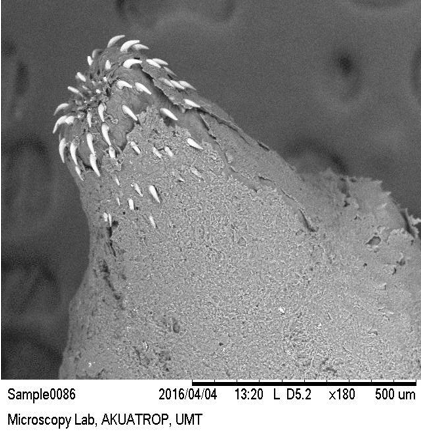
Figure 7: Bolbosoma sp. (a) adult body is cylindrical and is covered with a thick cuticle [Table-top electron microscope, 500mm].
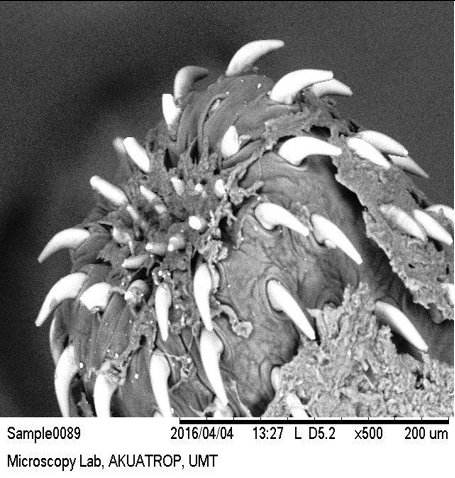
Figure 8: The anterior part of the proboscis had slender apical hooks, robust median hooks and reduced basal hooks [Table-top electron microscope, 500 mm].
On histological examination revealed no infection and no toxicity were found in all vital organ. The lung revealed emphysema and congestion which lead to poor gas exchange (Figure 9). Alveolar revealed the hyaline membrane lining the alveolar wall with severe pulmonary congestion and emphysema which lead to formation of macrophages and hyaline membrane. There also present of string of fibril, fibrocytes and macrophages which indicate chronic stage (Figure 11).
The liver revealed chronic starvation with disarranged of hepatocytes cells and hepatic atrophy (Figure 12).
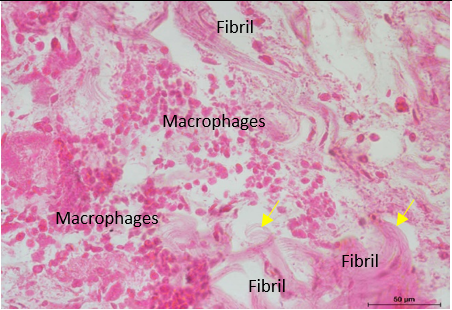
Figure 11: Lung - present of string of fibril, fibrocytes and macrophages which indicate chronic stage [X400 HE].
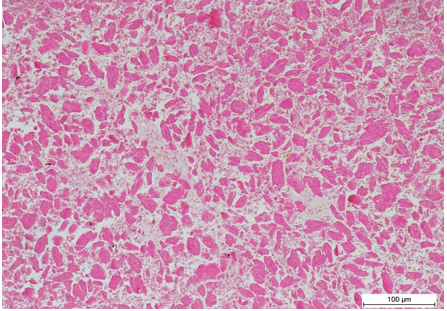
Figure 12: Liver – Disarranged of hepatocytes cells, hepatic atrophy indicate to chronic starvation [X200 HE].
Discussion and Conclusion
Cetacean stranding is a phenomenon in which cetaceans strand themselves on land, usually on a beach. Beached whales often die due to dehydration, collapsing under their own weight, or drowning when high tide covers the blowhole (Blood and Matt, 2012). Every year, up to 2,000 animals beach themselves (Martin and Anthony, 1991). Although the majority of stranding result in death, they pose no threat to any species as a whole. Only about 10 cetacean species frequently display mass beaching, with 10 more rarely doing so. Stranding can be grouped into several types. The most obvious distinctions are between single and multiple stranding. The carcasses of deceased cetaceans are likely to float to the surface at some point; during this time, currents or winds may carry them to a coastline. Since thousands of cetaceans die every year, many become stranded posthumously. Most carcasses never reach the coast and are scavenged or decomposed enough to sink to the ocean bottom, where the carcass forms the basis of a unique local ecosystem called whale fall. Single live stranding are often the result of illness or injury, which almost inevitably end in death in the absence of human intervention. Multiple stranding in one place are rare and often attract media coverage as well as rescue efforts. Even multiple offshore deaths are unlikely to lead to multiple stranding due to variable winds and currents.
Whale stranding occur in many parts of the world, and we don't know why. Scientists are still searching for the answers that will unlock this mystery. There are many theories about why whales and sometimes swim into shallow water and end up stranding themselves on beaches in various parts of the world. Some scientists have theorized that a single whale or dolphin may strand itself due to illness or injury, swimming in close to shore to take refuge in shallow water and getting trapped by the changing tide. Because whales are highly social creatures that travel in communities called pods, some mass stranding may occur when healthy whales refuse to abandon a sick or injured pod member and follow them into shallow water. Many beached whales in stranding associated with sonar also show evidence of physical injuries, including bleeding in their brains, ears and internal tissues. In addition, many whales stranded in areas where sonar is being used have symptoms that in humans would be considered a severe case of decompression sickness, or “the bends,” a condition that afflicts SCUBA divers who resurface too quickly after a deep dive. The implication is that sonar may be affecting the whales’ dive patterns. Other possible causes put forth for the disruption of whale navigation system, causing them to lose their bearings, stray into shallow water, and end up on the beach. These include weather conditions, diseases (such as viruses, brain lesions, parasites in the ears or sinuses), underwater seismic activity (sometimes called seaquakes), magnetic field anomalies; and unfamiliar underwater topography.
Si Corner have the lung problem earlier that made him being left behind by his group and get stucked in the mud. This can be seen in histology with the formation of fibrosis, emphysema and edema in the lung and hepatic atrophy which indicate chronic starvation. It believed that he also suffering from “Barotrauma or Decompression Sickness (DCS)” where affecting ear or lung problem which lead to unbalance movement due to different changes in air pressure. Decompression sickness starts with the formation and increase in size of extravascular and intravascular bubbles when the sum of the dissolved gas tensions (oxygen, carbon dioxide, nitrogen, helium) and water vapor exceeds the local absolute pressure. Barotrauma or Decompression Sickness (DCS) can be defined as a severe pain in muscles and joints, cramp, and difficulty in breathing, caused by a sudden and sustained decrease in air pressure, resulting in the deposition of nitrogen bubbles in the tissues due to a sudden drop in external pressure, as during a too rapid ascent from diving, and resulting in pain in the lungs and joints and faintness. A syndrome, including bends, chokes, neurological disturbances, and collapse. However no evidence of infection or toxicity was identified in these case.
Si Corner have the lung problem earlier that made him being left behind by his group and get stucked in the mud. This can be seen in histology with the formation of fibrosis, emphysema and edema in the lung and hepatic atrophy which indicate chronic starvation. It believed that he also suffering from “Barotrauma or decompression sickness” where affecting ear or lung problem which lead to unbalance movement due to different changes in air pressure. However no evidence of infection or toxicity was identified.
Acknowledgement
I wish to express appreciation to Syed Abdullah Syed Abdul Kadir from Fishery Research Institute Dungun, Terengganu; Haji Munir Mohd Nawi state Director, Department of Fishery, Johor, and Dato’ Dr. Kamaruddin Isa Director General, Department of Veterinary Services Malaysia for their advice and assistance with many aspects of this study.
I wish to express appreciation to Syed Abdullah Syed Abdul Kadir from Fishery Research Institute Dungun, Terengganu; Haji Munir Mohd Nawi state Director, Department of Fishery, Johor, and Dato’ Dr. Kamaruddin Isa Director General, Department of Veterinary Services Malaysia for their advice and assistance with many aspects of this study.
References
- Blood, Matt D. (2012). Beached Whales: A Personal Encounter. Sydney.
- Elliott DH and Moon RE. (1993). Manifestations of the decompression disorders. In: The Physiology and Medicine of Diving (4th ed.), edited by Bennett PB and Elliott DH. London: W. B. Saunders, p. 481- 505.
- Horwood J, editor. (1987). The sei whale: Population biology, ecology & management. London: Croom Helm. 375 p. 54.
- Jonsgård A, Darling K. (1977). On the biology of the eastern North Atlantic Sei Whale, Balaenoptera borealis Lesson. Reports of the International Whaling Commission Special issue 1: 124-125.
- Martin, Anthony R. (1991). Whales and Dolphins. London: Salamander Books Ltd.
- Nishi RY. (1993). Doppler and ultrasonic bubble detection. In: The Physiology and Medicine of Diving, (4th ed.), edited by Bennett PB and Elliott DH. London:W. B. Saunders, p. 433 - 453.
- Perry S, DeMaster DP, Silber GK (1999). The sei whale (Balaenoptera borealis). Marine Fisheries Review 61: 52-58.
Citation: Norina L., et al. (2020). Decompression Sickness (DCS) in a Sei Whale (Balaenoptera Borealis) Stranded In Batu Pahat, Johore, Peninsular Malaysia. Archives of Veterinary and Animal Sciences 2(1).
Copyright: © 2020 Norina L. This is an open-access article distributed under the terms of the Creative Commons Attribution License, which permits unrestricted use, distribution, and reproduction in any medium, provided the original author and source are credited.

